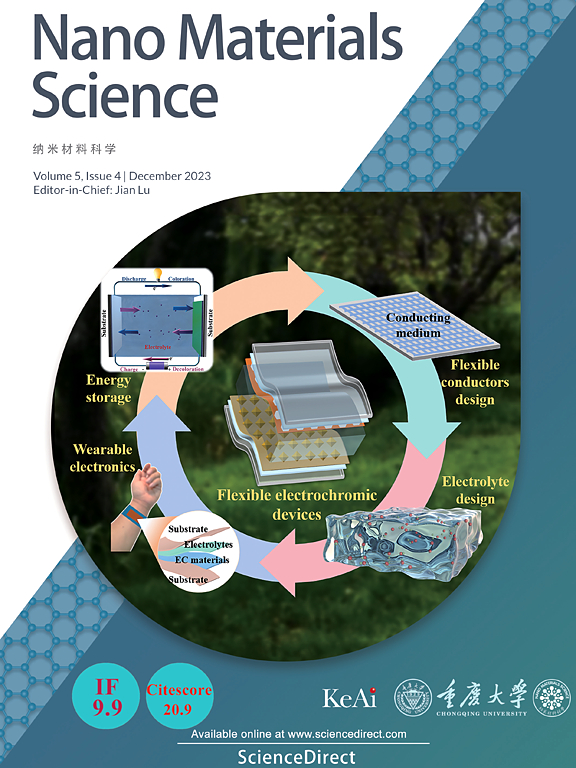等离子体au掺杂MOF与ZnIn2S4/MoS2纳米片在促进光催化析氢中的协同作用
IF 17.9
2区 材料科学
Q1 Engineering
引用次数: 0
摘要
构建明确、高效的z型异质结构,增强光生电荷载流子及其快速转移,对于实现高效的光催化制氢,实现碳中和至关重要。在此,我们通过合理构建具有局部表面等离子体共振(LSPR)性质的au -锚定的UiO-66-NH2,嵌入ZnIn2S4/MoS2纳米片来研究H2的演化反应。有趣的是,优异的异质结的协同效应,调节了额外的催化活性位点,在结界面上提供了光生电荷的有效分离,并为增强的电子转移建立了专用的微环境。值得注意的是,优化后的混合光催化剂(Au6@U6N)15/ZIS/MS5的产氢效率为58.2 mmol g−1 h−1,分别是原始ZIS和MS/U6N/ZIS的16倍和1.5倍。在420 nm波长处,它的表观量子效率为19.6%,超过了一些基于mof的ZnIn2S4光催化析氢活性。值得注意的是,本研究为具有层状封装异质结构的界面工程等离子体MOF的设计提供了见解,阐明了等离子体LSPR效应的作用,并通过增强的微通道有效地调节电荷转移,从而提高可见光驱动的光催化活性,实现高效的绿色能源转换。本文章由计算机程序翻译,如有差异,请以英文原文为准。
Synergistic role of plasmonic Au-doped MOF with ZnIn2S4/MoS2 nanosheets for boosted photocatalytic hydrogen evolution
The construction of a well-defined and efficient Z-scheme heterostructure with enhanced photogenerated charge carriers and their rapid transfer is vital for realizing efficient photocatalytic hydrogen production, to achieve carbon neutrality. Herein, we study the H2 evolution reaction by rationally constructing a hybrid Au-anchored UiO-66-NH2 with localized surface plasmon resonance (LSPR) properties, embedded with ZnIn2S4/MoS2 nanosheets. Interestingly, the synergistic effect of excellent heterojunction, tunes additional catalytic active sites, provides effective separation of photogenerated charges at the junction interface and establishes a dedicated microenvironment for the boosted electron transfer. Notably, the optimized hybrid photocatalyst (Au6@U6N)15/ZIS/MS5 exhibits highly efficient H2 generation of 58.2 mmol g−1 h−1, which is almost 16 and 1.5 folds of the pristine ZIS and MS/U6N/ZIS, correspondingly. It has an apparent quantum efficiency of 19.6% at a wavelength of 420 nm, surpassing several reported MOF-based ZnIn2S4 photocatalytic H2 evolution activities. Significantly, this research provides insights into the design of interface-engineered plasmonic MOF with layered encapsulated heterostructures that elucidate the role of plasmonic LSPR effect and efficiently regulate the charge transfer with enhanced microchannels, hence boosting the visible-light-driven photocatalytic activity for realizing efficient green energy conversion.
求助全文
通过发布文献求助,成功后即可免费获取论文全文。
去求助
来源期刊

Nano Materials Science
Engineering-Mechanics of Materials
CiteScore
20.90
自引率
3.00%
发文量
294
审稿时长
9 weeks
期刊介绍:
Nano Materials Science (NMS) is an international and interdisciplinary, open access, scholarly journal. NMS publishes peer-reviewed original articles and reviews on nanoscale material science and nanometer devices, with topics encompassing preparation and processing; high-throughput characterization; material performance evaluation and application of material characteristics such as the microstructure and properties of one-dimensional, two-dimensional, and three-dimensional nanostructured and nanofunctional materials; design, preparation, and processing techniques; and performance evaluation technology and nanometer device applications.
 求助内容:
求助内容: 应助结果提醒方式:
应助结果提醒方式:


